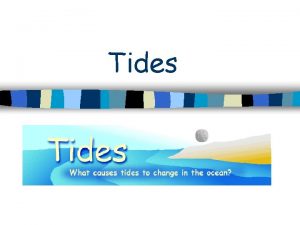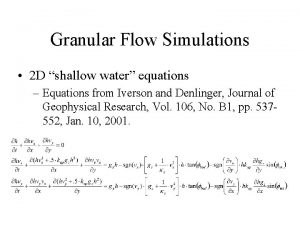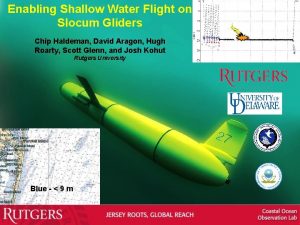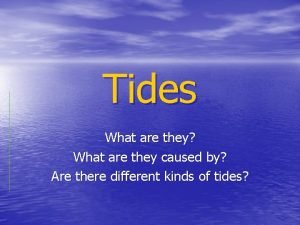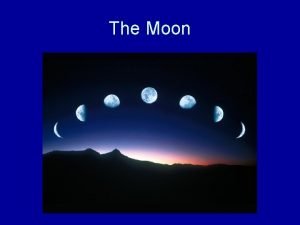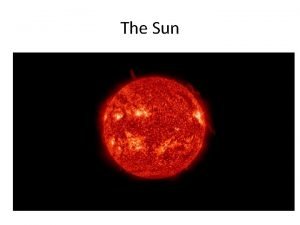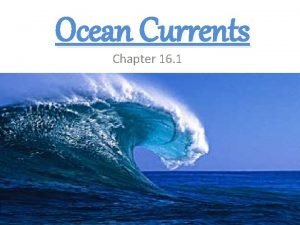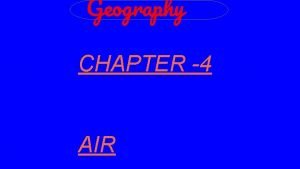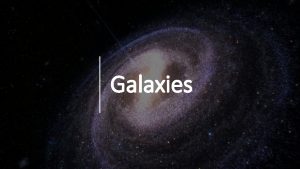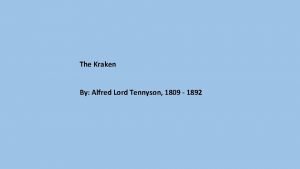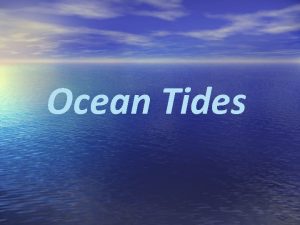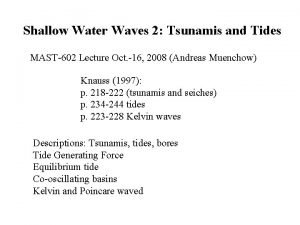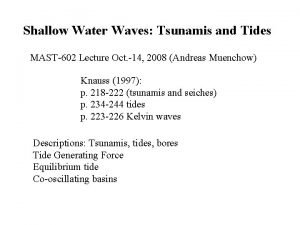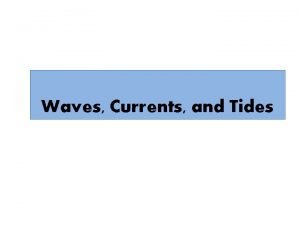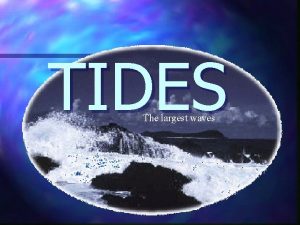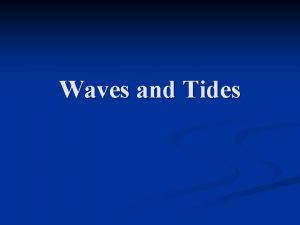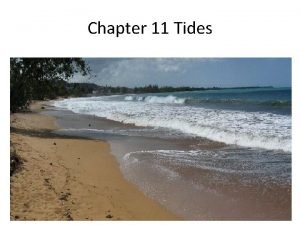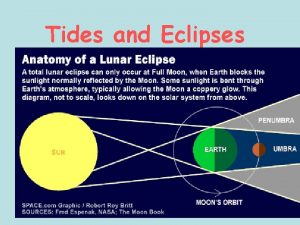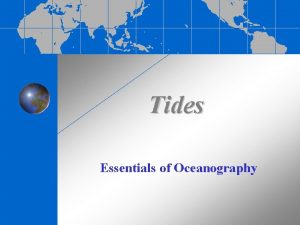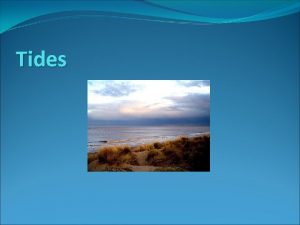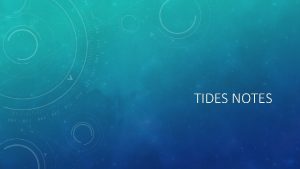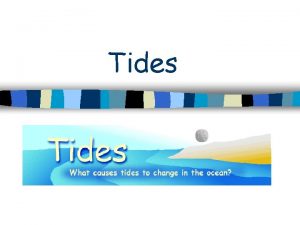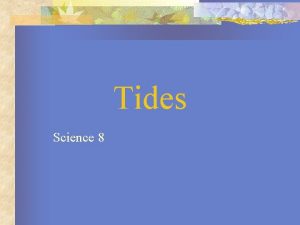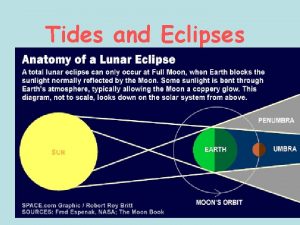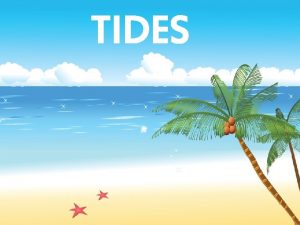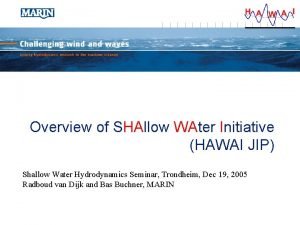Tides Tides are huge shallow water waves They





































- Slides: 37

Tides • • Tides are huge shallow water waves. They are caused by: - Gravitational force of moon and sun Motion of the earth

Tides • Tides are periodic, short-term changes in the height of the ocean surface at a particular place, due to gravitational attraction of the moon and sun and the motion of the earth. • Wavelength can be one half of the circumference of the earth.

Tides 1) Equilibrium theory of tides (due to position and attraction of earth, moon and sun only) 2) Dynamic theory of tides (takes into account water depth and interference of continents)

Tides • Moon has greatest effect on tides • Sun has about one half the effect

Tides • Lunar cycle - explanation of what we see • Equilibrium theory of tides - idealized view (attraction of earth, moon and sun and their motion) • Dynamic theory of tides - more realistic view (water depth, continents in the way, tide rocks back and forth in ocean basins)

-Lunar cycletidal day is 24 hrs, 50 min long

3 4 2 5 1 6 7 8

Some points about the earth/moon system: - Lunar day is 27 days, 7 hours, 43. 2 minutes - Moon rises 50 minutes later each day - High tide is 50 minutes later each day - Moon does not stay over the equator - Each month it moves 28. 5 degrees above and below the equator

View model of earth, moon and sun

Tides 1) Equilibrium theory of tides (due to position and attraction of earth, moon and sun only) - assumes that the ocean surface is in balance with the forces acting on it.

What is the affect of moon on the ocean surface? • Gravity tends to pull earth and the moon together • Inertia tends to keep them apart (“centifugal force”) • Earth and moon are in a stable orbit. Inertia keeps water in a bucket that swings overhead. Imagine two people holding hands and spinning Imagine earth and moon connected by a stick and orbiting - center of mass is about 1000 miles into earth.

Newton, 1687 The pull of gravity between two bodies is proportional to the masses of the bodies but inversely proportional the square of the distance between them. What does this mean? Heavy bodies attract each other more strongly. Gravitational attraction quickly weakens as the distance grows longer.

F= Gravitational attraction F = G (m 1 m 2/r 2) G= gravitational constant m 1 = mass of object one m 2 = mass of object two r = distance between their centers




moon does not stay over the equator - each month it moves 28. 5 degrees above and below the equator


Moon is closer to the earth so has a bigger effect than the sun, even though the sun is much larger (more massive). Sun has about 1/2 effect on ocean surface as does the moon.


Continents interfere with tide movement



Gulf of California Tide in a bathtub Mode at center of Gulf - least tide Extreme tides in N & S Gulf North - shallower, most extreme tides “seiche”

How are tides measured? • Depth guages measure depth change at a site • One year of data per site is minimum necessary • Need 18. 5 years to most astronomical data and most accurate record for tides at a spot.

Types of tides Diurnal (one low, one high per day) Semidiurnal (two lows, two highs per day) Mixed (lows and highs are unequal)

Spring tides (springen - “to move quickly”) During full and new moons Most extreme tides Neap tide (naepa - “hardly disturbed”) During quarter moons Least extreme tides

Tides • • Tides are huge shallow water waves. Caused by gravitational force of moon and sun, & motion of the earth Moon exerts a greater tidal effect than does sun Ocean basins and water depth influence tides

Ocean currents and upwelling

Ocean currents and upwelling Why does water pile up in the western Pacific and how does this lead to upwelling in the eastern Pacific? - Sun drives wind -Wind drives currents

Ocean currents and upwelling Strong southeasterly winds prevail along S. America Coast. Coriolis Effect due to earth’s rotation drag water to the left (northwest). Cold deep water comes to surface to replace the surface water = upwelling.

Ocean currents and upwelling - Sun drives wind -Wind drives currents -Earth’s rotation to the east causes wind and water to: -Deflect to the right in the Northern hemisphere - Deflect to the left in the Southern hemisphere -Leads to gyres (huge circular currents) in the ocean basins -Leads to Trade Winds at Equator (Easterlies) -Leads to Westerlies at Poles -Water piles up on the western boundaries of oceans -Water blown from shore on the eastern boundaries of oceans -Upwelling occurs when water blown from shore

Effects of tides on life in the intertidal • Intertidal zone - what is it? • What is it like to live there?

Effects of tides on life in the intertidal • Intertidal zone - what is it? Area of the shore that is uncovered and covered by the tides each day. • What is it like to live there? Good! (soup of food, gases, mobility for larval forms, etc) Challenging at the interface of land sea What are some of challenges?

Life in the intertidal Challenges: Physical factors Desiccation (drying), heat, wind, waves Biological factors Competition, predation, mutualism, commensalism

life in the intertidal Diversity- most phyla are marine 35 -39 phyla of animals, most are marine, majority exclusively marine (insects dominate on land) Differences between life in sea versus land: Lots of suspension, filter and deposit feeders Larval stages are mobile Radial symmetry not uncommon Many sessile animals

Research (“Intertidal Stories”) at Rocky Point – – – Sponge isopod and three male forms Seastar plague from El Nino (1978 - present) Angelic tooth snail and barnacles Nerite snail “arms race” with lumpy claw crab Hermit crab zonation and clumping Invasion of the killer hydroid
 Antigentest åre
Antigentest åre The difference between spring tides and neap tides
The difference between spring tides and neap tides Spring tide position
Spring tide position Water and water and water water
Water and water and water water Ocean currents waves and tides
Ocean currents waves and tides Diurnal tides
Diurnal tides Bangladesh is blessed with huge inland open water resources
Bangladesh is blessed with huge inland open water resources Internal wave
Internal wave Shallow water equations python
Shallow water equations python Haldeman
Haldeman Swb stromausfall
Swb stromausfall What are tides and how are they caused
What are tides and how are they caused 4 phases of the moon
4 phases of the moon Mechanical waves examples
Mechanical waves examples Light and sound travel in waves true or false
Light and sound travel in waves true or false Example mechanical waves
Example mechanical waves Similarities of mechanical and electromagnetic waves
Similarities of mechanical and electromagnetic waves Characteristics of a longitudinal wave
Characteristics of a longitudinal wave Sound is a longitudinal wave
Sound is a longitudinal wave Short wave vs long wave radiation
Short wave vs long wave radiation Difference between matter waves and electromagnetic waves
Difference between matter waves and electromagnetic waves Electromagnetic waves vs mechanical waves
Electromagnetic waves vs mechanical waves Mechanical waves and electromagnetic waves similarities
Mechanical waves and electromagnetic waves similarities Seismic waves
Seismic waves Seismic waves are mechanical waves
Seismic waves are mechanical waves Compare and contrast p waves and s waves using venn diagram
Compare and contrast p waves and s waves using venn diagram Mechanical waves and electromagnetic waves
Mechanical waves and electromagnetic waves Differences between constructive and destructive waves
Differences between constructive and destructive waves The sun is huge
The sun is huge Exploding comfortably down on the cliffs
Exploding comfortably down on the cliffs Large monuments created by huge stones
Large monuments created by huge stones Which features of the sun look like huge cloudlike arches?
Which features of the sun look like huge cloudlike arches? Are huge circular moving current systems
Are huge circular moving current systems Our earth is surrounded by a huge blanket of
Our earth is surrounded by a huge blanket of Largest galaxy
Largest galaxy Big huge labs trading cards
Big huge labs trading cards A luminous ball of gas
A luminous ball of gas The kraken poem
The kraken poem

